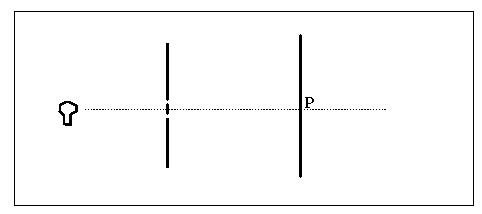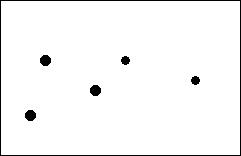ASTRONOMY 102 HOUR EXAM #1
BUCKNELL UNIVERSITY
Astronomy 102
First Hour Exam
|
1999 February 19
|
This Exam will be scored on a 100 point scale and has two parts:
a multiple choice/short answer section of 13 questions each worth 3 points
and a problem section with 3 problems, each worth 20 points.
You earn 1 point for writing your name on this exam.
Here are some quantities and relationships that you might find useful:
for a sphere: surface area = 4 x pi x radius2
distances: 1 Astronomical Unit = 1.495 x 1011 m
1 parsec = 3.09 x 1016 m
luminosity: 1 Lo = 3.8 x 1026 W
for a wave: speed = wavelength x frequency
for light waves: energy = h x frequency = h x c/wavelength
the speed of light: c = 3 x 108 m/sec
the speed sound in air: cs = 340 m/s
Planck's constant: h = 6.626 x 10-34 J s
for blackbody emitters: intensity = sigma x temperature4
sigma = 5.67 x 10-8 W/(m2
K4)
luminosity = intensity x surface area
wavelength of spectrum peak =(0.003 m K)/temperature
Doppler formula: speed of emitter change in frequency
------------------- = --------------------
speed of wave rest frequency
magnitude scale: difference of one magnitude corresponds to a
factor of 2.512 in flux
flux: flux = luminosity/(4 x pi x distance2)
The observer's triangle relation:

alpha/57.3o = w/R
Multiple Choice Questions:
Click on the highlighted letter of the correct answer to get an
explanation.
1) When stars like the Sun run out of hydrogen to fuse
in their cores, they "puff up," becoming many times larger in radius,
and their outer layers cool off a little bit (from, say 5800 K to
about 4000 K). How would the position on the H-R Diagram of such a
star change as it transforms from its Main Sequence (a.k.a. H-fusing)
stage to this post-Main Sequence stage?
- a) It would move downward and to the left.
- b) It would move upward and to the left, along the Main Sequence.
- c) It would move upward and to the right.
- d) It would move downward and to the right, along the Main Sequence.
2) Light from a light bulb passes through a screen with
two small openings and because light is a wave, produces an
interference pattern of light and dark fringes on the second screen.

Consider the point labeled P on the second screen. It is on the
symmetry axis of the problem; that is, P is at the point where a
straight line from the light bulb and passing directly in between the
two slits in the first screen meets the second screen. Based on the
geometry of the situation, what would you expect to see on the second
screen at point P?
- a) a bright "fringe," signifying constructive
interference of the waves from the two slits.
- b) a dark "fringe," signifying destructive interference of the waves from
the two slits.
- c) there isn't enough information to determine whether it will be bright
or dark.
3) Name the constellation depicted in the diagram below:

- a) Cassiopeia
- b) Cepheus
- c) Camelopardis
- d) Cancer
4) Choose the warmest of the following zones of the Sun
- a) the spicule zone
- b) the chromosphere
- c) the photosphere
- d) the corona
5) From a distance of 100 meters, you watch your friend
is hammer a nail into a block of wood. What is the time interval
between the time you see him hit the nail, and the time you hear the
hammer blow?
- a) 3.4 seconds.
- b) 0.29 seconds
- c) 3.3 x 10-7 seconds
- d) 0 seconds
6) Sirius has an apparent magnitude of -1.5, while
Adhara (one of the stars in the Big Dipper) has an apparent magnitude
of 1.5. What is the ratio of the fluxes from these two stars?
- a) 2.512
- b) 3.0
- c) 7.536
- d) 15.85
- e) 72.46
7) Two Main Sequence stars are located at the same
distance from Earth. One has a surface temperature of 3000 K, while
the other has a surface temperature of 6000 K. Which star will appear
brighter to the naked eye?
- a) the 3000 K star
- b) the 6000 K star
- c) they will have equal flux
- d) you can't tell without knowing the size of each star
8) A hypothetical atom has the following energy structure:
ground state: energy = 0 Joules
first excited state = 2.1 x 10-22 Joules
second excited state = 3.2 x 10-22 Joules
third excited state = 4.9 x 10-22 Joules
If an atom of this species is in its second excited state, it can
absorb a photon of which of the following energies?
- a) 3.2 x 10-22 Joules
- b) 1.1 x 10-22 Joules
- c) 1.7 x 10-22 Joules
- d) 2.8 x 10-22 Joules
- e) both a) and b)
9) A star with a surface temperature of 3000 K will
emit a blackbody spectrum which peaks at what wavelength?
- a) 1 x 10-6 m
- b) 9 x 10-7 nm
- c) 9 nm
- d) 100 nm
- e) 1000 m
10) A Main Sequence M star has a radius of about 7 x
107 m and a surface temperature of about 3000 K. An M supergiant star
has the same surface temperature, but has a radius 1000 times
bigger. How much more luminous is the M supergiant than the Main
Sequence M star?
- a) they have the same luminosity
- b) the M supergiant is 1000 times more luminous
- c) the M supergiant is a million times more
luminous
- d) you can't tell without knowing the distances to the two stars

11) The diagram above shows a collimated telescope
whose objective and eyepiece are separated by 1.5 meters. If the
eyepiece has a focal length of 25mm, what is the focal length of the
objective?
- a) 2.5 x 10-2 m
- b) 0.6 m
- c) 1.475 m
- d) 6 m
- e) 15.95 m
12 and 13) (i.e., this one is worth 6 points) Briefly
explain how astronomers conclude that all stars are made of mostly
hydrogen even though some stars don't show strong hydrogen absorption lines.
Answer
Problems:
(Show your work!! I will be very generous with partial credit!!!)
Problem 1)Two stars in the M67 star
cluster have an angular separation of 0.12 degrees. If both stars are
located at a distance of 791 pc, how far are these st ars from one
another?
ANSWER
Problem 2) A Main Sequence
G star has a surface temperature of 5800 K while a Main Sequence M
star has a surface temperature of 3500 K. The G star has a radius ten
times bigger than the M star. Calculate the ratio of their
luminosities.
ANSWER
Problem 3) A giant cloud of
excited hydrogen gas is moving toward the Earth at a speed of 200,000
m/s. Several of the hydrogen atoms in the cloud make a transition from
the N=77 energy state to the N=76 energy state, releasing photons of
energy 9.74 x 10-24 J. What is the frequency of the
radiation from this cloud that observers on the Earth would measure?
ANSWER



